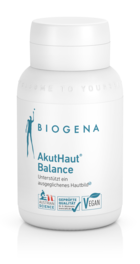What do your intestines and your skin have in common? A lot. Although invisible to the naked eye, a look under the microscope reveals that both tissues are home to astonishing flora. With around one billion microorganisms per gram of intestinal wall, the large intestine is one of the most densely populated places in the world. The surface of our skin is also full of life: There are about as many microbes per two square meters of skin as there are people on Earth – an incredible piece of data. Upon closer examination, it's no surprise that there's a close connection between these two organs and their extensive microflora. How does it work? Let's dive into their relationship and find out.
We know that good skin reflects a healthy gut – and there's scientific evidence to back it up.
Your skin and gut go hand-in-hand. It may sound romantic, but the facts are rather dry. The skin and intestines are not only the human organs with the largest surface area and the densest microbe population, they also develop from the same embryonic layer. These two organs, with their extensive nerve and blood vessel networks, are also connected through the immune system. So it's no wonder that these structures have a close relationship, as studies on the intestines’ influence on skin health have shown.
Although there is still much to learn about the underlying mechanisms, it seems that the immune system plays a particular role in facilitating the gut-skin axis of connection. The intestinal flora, weighing a total of one to two kilograms, pulls the strings by continuously interacting with immune cells to trigger the production of antibodies. This immunity-building exercise benefits the skin as well as the intestines.
Think of your intestinal flora as a powerful chemical laboratory in your belly, which produces a variety of different substances – including key materials for skin health, like hyaluronic acid or the skin-friendly vitamin biotin, in addition to substances that support the gut's ability to digest and process food. Ultimately, it is this “cocktail” of substances in the intestines that manipulates the nervous system, which in turn influences circulation to the skin, among other things.
Skin problems: Sensitivity.
Our skin has a language of its own. It uses this language to tell us about our habits, emotions, or physical and mental equilibrium. The appearance of redness, irritation, tightness, or blemishes, for example, quickly leaves us feeling uncomfortable in our skin. But what is bothering this sensitive organ?
Apart from the natural, genetically influenced process of skin aging, other factors can pose additional challenges for our skin. These include excessive sun exposure, certain medicines, or improper skin care routines. An unhealthy lifestyle also leaves its mark on the skin – alcohol, nicotine, lack of sleep, stress, dehydration and, last but not least, poor nutrition –all can negatively affect the skin's appearance.
The Gut-Skin Axis: When the intestines are in trouble, the skin suffers along with them.
“You are what you eat,” the saying goes, and it's true: sensitive reactions in your belly are reflected in your skin. This relationship has been the focus of several studies, which show that people with skin problems are often found to have compromised intestinal flora (e.g. not enough lactobacilli and bifidobacteria) or intestinal walls – problems that can worsen with stress (Hello, gut-brain axis)!
In addition to stress, medicines like antibiotics or laxatives, as well as an unhealthy diet lacking proper nutrients (see boxes) can also lower the diversity of gut bacteria. Studies have shown that tribal populations have a larger variety of microbial species in their intestines than industrialized populations, whose diets and lifestyles contribute to a loss of 40% of this diversity. This decrease also impacts the cocktail of substances created by the bacteria, as well as the intestinal flora's ability to extract nutrients from our food and protect us from toxins. Ultimately, this shows up in our skin, thanks to the connection explained above.
Taking care of your microbes to boost your skin: nutritional support for the skin and gut.
Which intestinal bacteria support the skin?
If you struggle with problem skin, make sure to take care of your digestive tract as well as your skin. To support helpful gut microbes – especially lactobacilli and bifidobacteria – you need to provide them with the right fuel.
Fibre & bitter substances and their function for the skin and bowel
These bacteria like to feed on soluble fibre, which is especially abundant in plant-based foods (fruit, vegetables, whole-grain products, legumes): black salsify, parsnips, and sunchokes are particularly high on this list. Certain bitter plants like milk thistle and artichokes are also very good for your gut. They help to stimulate the liver and gallbladder, supporting the intestines’ digestive process. A happy centre of the body is ultimately “savoured” by our skin.
Which vitamins can support the skin and intestines?
Because of their particularly active metabolism, both skin cells and the intestines’ mucous membrane cells require a good supply of nutrients. Make sure to consume sufficient quantities of the right vitamins to keep both of these “barrier” organs in good condition for as long as possible: Vitamins A, B2, niacin, and biotin have been proven to support healthy mucous membranes. Meanwhile, vitamins C, E, and biotin benefit your skin from the inside. Biotin helps you achieve healthy skin, while vitamin C supports the production of collagen – an important component in connective tissue – for normal skin function. Vitamin C and vitamin E also work together to protect the cells from oxidative stress, which can be caused by UV rays among other sources, and regenerates vitamin E as it is consumed.
Things that the intestines and intestinal bacteria don't like
- low fiber
- lots of sugar
- lots of unhealthy fats
- high protein content
- alcohol
- food additives (found in highly processed foods like ready meals, prepared sauces, etc.)
- certain medications (antibiotics, laxatives, contraceptives, hormone supplements, etc.)
Things the intestines and intestinal bacteria love
- soluble fiber from fruits, vegetables, legumes, and whole-wheat products
- bitter plants like milk thistle and artichokes
- fermented foods, like sauerkraut
- for healthy mucus membranes: vitamins A, B2, niacin, biotin
- sufficient liquids, like water or unsweetened herbal tea
- choose preparation methods that preserve nutrients (steaming or simmering instead of roasting or frying over high heat)
- chewing properly
- eating meals in a peaceful and quiet atmosphere
What is good for the skin:
Did you know that your intestines need exercise? Couch potatoes are more likely to suffer from constipation, while regular endurance training (ideally, 30 minutes per day) improves both circulation and digestion. When the intestines are better supplied with blood, they can transport food more quickly.
Happy intestinal flora, happy skin
Studies show that beautiful complexions start in the gut, with increasing evidence that a balanced gut microbiome is important for healthy skin. Professor Michael Sterling, M.D. of the Erlangen Skin Clinic, reports on the fascinating connection between skin and intestinal flora in his 2020 article in Kompass Autoimmun, a journal on autoimmune disorders.
Unbalanced diets, sugar, and alcohol – for people with sensitive skin, even brief indiscretions can have lasting dermatological effects. All the more reason why scientists have long been investigating the exact connection between gut health and the skin's appearance.
The Intestine, a Beauty Organ
Our intestines are home to billions of microbes. This impressive microbiome's important role isn't restricted to the intestines. In addition to providing digestive support, these bacteria train the immune system, serve as our bodyguards, and manufacture various substances (including certain vitamins, antioxidants, and hyaluronic acid). Their influence extends far beyond the digestive tract and includes the state of our skin. Results from current studies continue to underscore the importance of healthy gut flora for the skin.
An imbalance in your microbiome – even if it doesn’t cause any other symptoms – can show up in your skin because it affects the “cocktail” of substances produced in your intestines: This imbalance may lead to excess free phenols and paracresol, for example, which compromises the intestinal barrier, and can impact the production of substances used by the skin (hyaluronic acid, vitamins, antioxidants) or the ability to extract valuable antioxidants from your food.
Summary:
A balanced gut microbiome is important not only for the intestines but also for other organs like the skin. If you want your gut bacteria to contribute to your beauty regimen, make sure to take good care of these microbes.
Literature with the author.









